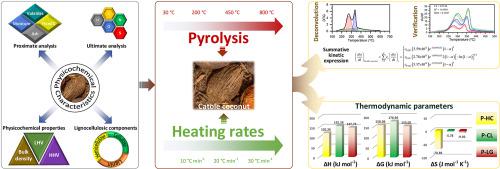Renewable Energy ( IF 8.7 ) Pub Date : 2021-09-16 , DOI: 10.1016/j.renene.2021.09.053 José Luiz Francisco Alves 1 , Jean Constantino Gomes da Silva 1 , Guilherme Davi Mumbach 1 , Rennio Felix de Sena 2 , Ricardo Antonio Francisco Machado 1 , Cintia Marangoni 1

|
Catole coconut (Syagrus cearensis) is produced in abundance in the Northeastern region of Brazil, but still remains relatively unexploited for bioenergy purposes because of the little relevant scientific information available. In this context, this study aims to investigate the kinetics and thermodynamics that describe the pyrolysis of catole coconut through a multi-component approach, aiming to highlight its bioenergy potential. Thermogravimetric analysis of catole coconut was performed in an inert atmosphere with different heating programs (10, 20 and 30 °C min−1) to establish its pyrolysis behavior. The resulting pyrolysis behavior was subjected to deconvolution by the symmetrical Gaussian function to specify three independent components: pseudo-hemicellulose, pseudo-cellulose, and pseudo-lignin. By using four isoconversional methods, the average activation energy estimated is in the range of 124.2–133.5 kJ mol−1 for pseudo−hemicellulose, 159.7–170.1 kJ mol−1 for pseudo−cellulose, and 151.5–162.8 kJ mol−1 for pseudo−lignin. Based on the kinetic compensation effect, the pre-exponential factors were determined to be in the range of 3.5 × 1011–5.4 × 1014 min−1. Statistical results (R2>0.954 and Fit>0.944) indicate that the proposed summative kinetic expression proved to be valuable in reproducing the experimental pyrolysis behavior. The promising findings acquired from this study justify the interest in exploring catole coconut as a new bioenergy feedstock.
中文翻译:

Catole 椰子(Syagrus cearensis)作为一种新的生物能源原料的前景:从物理化学特征、热解动力学和热力学参数的见解
Catole 椰子(Syagrus cearensis)在巴西东北部地区大量生产,但由于可用的相关科学信息很少,因此仍然相对未开发用于生物能源目的。在此背景下,本研究旨在通过多组分方法研究描述 catole 椰子热解的动力学和热力学,旨在突出其生物能源潜力。在惰性气氛中使用不同的加热程序(10、20 和 30 °C min -1) 以确定其热解行为。得到的热解行为通过对称高斯函数进行解卷积以指定三个独立的成分:伪半纤维素、伪纤维素和伪木质素。通过使用四个等转化率的方法,估计的平均活化能是在124.2-133.5千焦摩尔的范围-1为伪半纤维素,159.7-170.1千焦耳摩尔-1为伪纤维素和151.5-162.8千焦耳摩尔-1伪-木质素。基于动力学补偿效应,指数前因子被确定在3.5 × 10 11 –5.4 × 10 14 min -1 的范围内。统计结果 ( R 2 >0.954 和拟合> 0.944) 表明所提出的总结性动力学表达式在再现实验热解行为方面被证明是有价值的。从这项研究中获得的有希望的发现证明了将 catole 椰子作为一种新的生物能源原料的兴趣。



























 京公网安备 11010802027423号
京公网安备 11010802027423号